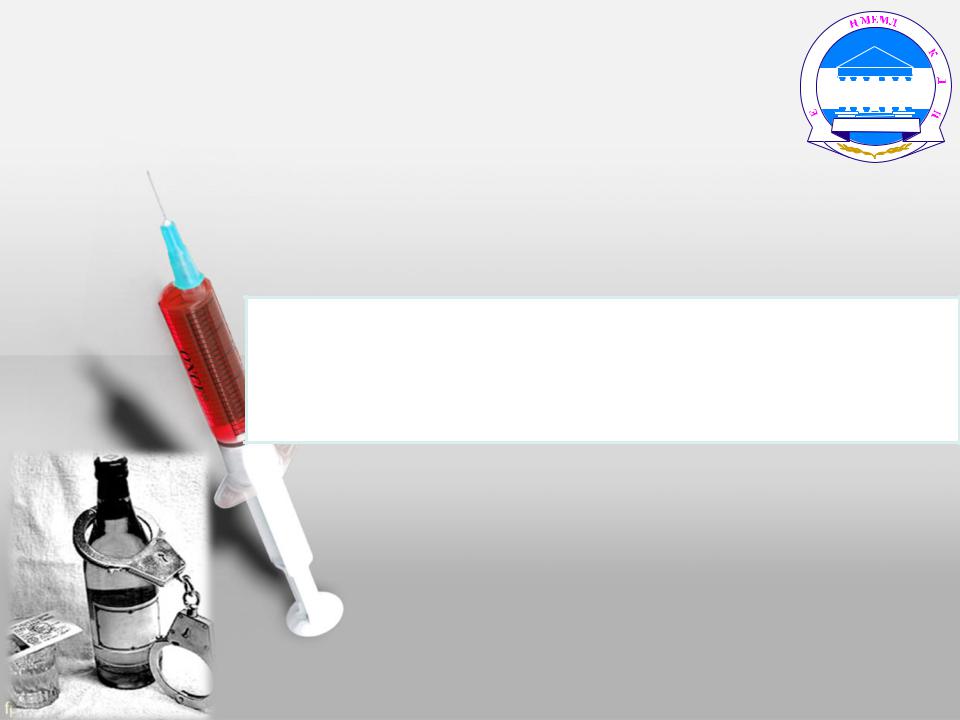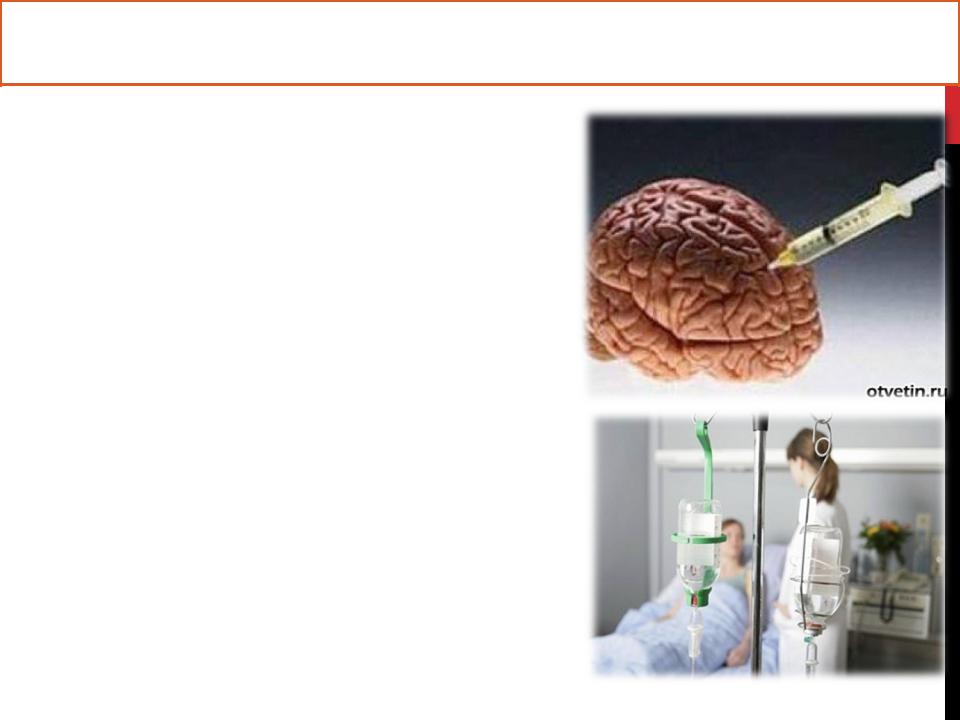
- •MINISTRY OF HEALTH OF THE REPUBLIC OF KAZAKHSTAN SEMEY STATE MEDICAL UNIVERSITY CHAIR
- •Plan:
- •INTRODUCTION
- •1. GENERAL - MEDICAL, SOCIAL AND LEGAL ASPECTS OF DRUG ADDICTION, TOXICOMANIAS AND
- •From the legal point of view not all substances corresponding to definition of
- •2. ETIOLOGY, PATHOGENESIS, STAGES OF DRUG
- •Etiology of drug addiction and toxicomanias
- •General pathogenesis of drug addiction and toxicomanias
- •Consumption of psychoactive substances
- •Formation of mental dependence on the substance
- •Termination of drug proceeds
- •Stages of narco- and toxicomanias
- •The stage of physical dependence is characterized by formation of the following complex
- •Final stage ( somatic, decompensations, exhaustions) is characterized by formation of the following
- •3. ALCOHOLISM, CONCEPT, STAGES,
- •Weight of alcoholic intoxication depends on concentration of alcohol in blood, alcohol intake
- •Stages of alcoholism
- •The mechanism of toxic effect of alcohol on CNS
- •Conclusion
- •References:

MINISTRY OF HEALTH OF THE REPUBLIC OF KAZAKHSTAN 



 SEMEY STATE MEDICAL UNIVERSITY
SEMEY STATE MEDICAL UNIVERSITY 



 CHAIR OF PATHOLOGICAL PHYSIOLOGY
CHAIR OF PATHOLOGICAL PHYSIOLOGY 





















 УНИВЕРСИТЕТI
УНИВЕРСИТЕТI 
SIW
PATHOPHYSIOLOGICAL ASPECTS OF ALCOHOLISM, DRUG ADDICTION AND TOXICOMANIA
Prepared by: student of 244 group Nurtoleuova K
Checked by: professor Unisyanova M.M.
.
Semey, 2014

Plan:
I. Introduction
II. The main part
1.General - medical, social and legal aspects of drug addiction, toxicomanias and alcoholism.
2.Etiology, pathogenesis, stages of drug addiction and toxicomanias
3.Alcoholism, concept, stages, pathogenesis.
III.Conclusion References

INTRODUCTION
Entering in the XXI century, the mankind at last realized that besides ecology in general, exists also ecology of the person which safety will be provided only if effective means of fight against "civilization diseases" among which one of the major places occupies drug addiction, toxicomanias and alcoholism.
The problem of fight against alcoholism, drug addiction and toxicomanias is one of the most drama problems in the majority of the countries of the world. Medico-social value of a problem is defined first of all by considerable prevalence of alcohol intake, drugs and toxic substances that conducts to harmful consequences for population health as a whole.

1. GENERAL - MEDICAL, SOCIAL AND LEGAL ASPECTS OF DRUG ADDICTION, TOXICOMANIAS AND ALCOHOLISM.
The great attention to a problem of drug addiction, toxicomanias and alcoholism generates confusion in application of the terms "drug", "narcotic substance", "drug addiction", "toxicomania" etc. Therefore it is necessary to understand terminology and to divide medical, social and legal spheres of its application.
From a medical point of view is important damage to the body caused by drugs.

From the legal point of view not all substances corresponding to definition of World Health Organization, belong to drugs, but only those, what are included by special service of each state in the List of narcotic substances.
In Kazakhstan the List is formed by the State Commission at the Government of the Republic of Kazakhstan to control the spread of drugs. Inclusion of substances in list entails very serious consequences in the form of application of the appropriate articles of national criminal law for the illegal use .
Under the social aspect of it is meant that the non-medical use of these substances takes such a scale that threatens not only the individuals, groups, but to the whole of society, i.e. acquires social significance.

2. ETIOLOGY, PATHOGENESIS, STAGES OF DRUG
ADDICTION AND TOXICOMANIAS
Drug addiction / Toxicomania - the standard form of psychosomatic disorders . Manifested persistent craving for readmission appropriate psychoactive substance , usually in increasing doses . Characterized by mental and physical dependence , manifested the development of withdrawal symptoms when you stop taking it . Accompanied by pathological changes in personality development of complex mental , neurotic , autonomic and somatic disorders.
Drug addiction - forms of pathology caused by the means included in the official list of drugs.
Toxicomanias - forms of pathology, forming the abuse not related to drug substances (including drugs and alcohol ) .

Etiology of drug addiction and toxicomanias
Remedies causing drug addiction. For example: 1.Opiates ( heroin, morphine , opium
preparations , such omnopon );
2.CNS stimulants ( cocaine, marijuana , and other drugs of Indian Canaple);
3.Hallucinogens ( lysergic acid diethylamide - LSD , mescaline );
Toxicomanic substances, which are used with non – medical purposes:
1.Some chemical reactants; 2.Household chemical substances (glue); 3.Ethanol;
4.Medicines, doesn’t corresponds to narcotics.

General pathogenesis of drug addiction and toxicomanias
Drugs and substances for abuse are differences in the structure and mechanism of action. However, the formation of psychic and physical dependence, the implementation of their pathogenic effects in the body have a number of common patterns.
Common components of the pathogenesis of narco- and toxicomanias
|
|
|
|
Tolerance |
|
Formation |
Pathological |
|
Formation of |
|
|
||
inclination to |
|
mental |
|
change to |
|
of physical |
the repeated |
|
dependence on |
|
psychoactive |
|
dependence |
use of |
|
substance |
|
agent |
|
on |
psychoactive |
|
|
|
|
|
substance |
|
|
|
|
|||
agent |
|
|
|
|
|
|
|
|
|
|
|
|

Consumption of psychoactive substances
Release of neurotransmitters: dopamine, etc.
Positive emotions, state of psychological and physical comfort
Formation of reinforcements (maintaining state comfort)
Increasing the viscosity of cell membranes (including neurons)
Increased mobility of receptors
Increased interaction of receptors with neurotransmitters

Formation of mental dependence on the substance
Psychoactive drugs gradually depletes neurotransmitters in neurons and terminals
Deficiency of dopamine and other catecholamines
Decreased activity of reinforcements to maintain the state of comfort
Psycho-emotional discomfort (depression, anxiety, depression)
Forms need to re-stimulate the body of by psychoactive drugs
